Express trains in India
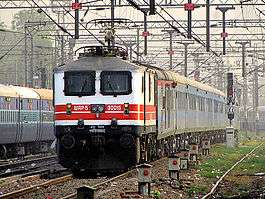

Mail/Express trains are Regular Express rail service of India. Express trains make small number of stops, unlike Passenger/Local train. In some cases, trains run express where there is overlapping local train service available, and run local at the tail ends of the line, where there is no supplemental local service. Because of their limited stops, these trains are able to obtain the highest speeds of any trains in India.
An express train is one where the average speed, excluding halts, is greater than 36 km/h. Including halts speed may sometimes fall into the region of around 20 km/h, for express trains.
The Duronto Express trains introduced in 2009 (which run between major cities without any intermediate halts) are projected to be the fastest train in India when new services are introduced with a higher speed limit of 120-130 km/h. Despite being limited to a lower speed limit, they take as much time as a Rajdhani or Shatabdi on the same route, courtesy the non-stop nature of their journey (see Tracks and Speed sections). Rajdhani Express which connects New Delhi with the state capitals in India was introduced in 1969, travels at speeds up to 130 km/h.
Non reserved travelling on Express trains
Indian railways run non reserved train as well as have unreserved/general compartment on Express/Mail trains.
- Non reserved trains
Indian railways run non reserved trains under the brand Jan Sadharan Express. These trains have all Unreserved/General coaches. A new series of Antyodaya Express is also proposed in rail budget 2016 - 2017 which will operate on peak routes having more rush. These trains will have all non reserved coaches.
The following Jan Sadharan Express run in India:
- 13257/13258 - Rajendranagar Anand Vihar Jan Sadharan Express (Daily)
- 12597/12598 - Gorakhpur Mumbai Jan Sadharan Express (Weekly)
- 15101/15102 - Chhapra - Mumbai (Weekly)
- 13257/13258 - Danapur - Anand Vihar (Delhi) (Daily)
- 15559/15560 - Darbhanga - Ahmedabad (Weekly)
- 15269/15270 - Muzaffarpur - Ahmedabad (Weekly)
The following trains are proposed under Antyodaya brand: [2]
- 15563/15564 - Jaynagar - Udhana (Surat) (Weekly)
- 15567/15568 - Darbhanga - Jalandhar (Weekly)
- 22841/22842 - Santragachi (Kolkata) - Chennai (Weekly)
- 22877/22878 - Howrah (Kolkata) - Ernakulam (Weekly)
- 22885/22886 - Tatanagar - Mumbai LTT (Bi-weekly)
- 22895/22896 - Bilaspur - Firozpur (Weekly)
- 22921/22922 - Bandra T. (Mumbai) - Gorakhpur (Weekly)
- 22631/22632 - Bikaner - Chennai
- Unreserved coaches
Apart from Antyodaya and Jan Sadharan trains, unreserved/general coaches are non reserved coaches on normal Express / Mail. The restriction on such coaches is for 24 hours journey. A new series of Deen Dayalu coaches has also been proposed in rail budget 2016 - 2017 for long distance trains. The Deen Dayalu coaches will be more comfortable than the old coaches
Competition
Like elsewhere, railways in India compete with air travel and road transport. The advantages of travelling by air between cities are the greater frequency of flights, and shorter travel time. Rail travel, with few exceptions (if any), offers lower cost.
Rail transport also faces competition from the use of roads improved under National Highways Development Project. People owning cars can, for short distances, benefit in terms of shorter travel time, given the lack of commute to and from a railway station at both ends of a journey. This is also balanced against the need to maintain one's vehicle and its security during such trips.
Tracks
Duronto, Shatabdi, and Rajdhani trains run on Indian broad-gauge which is 5 ft 6 in (1,676 mm). These tracks are multi-purpose supporting all passenger and freight traffic, and are not made exclusively for lighter load fast-express passenger trains. They run on tracks with classifications Group A, permitting speed up to 160 km/h, and Group B for speed up to 130 km/h. Lower speed limits apply when they are on tracks or railway switches, which have lower speed limits. The design of the railway switches, with a speed limit of 50–90 km/h, is the major bottleneck to higher speed.[3] Another constraint is the need to accommodate freight trains at the current top speed of 70 km/h.[4] These constraints to speed are consequences of sharing tracks with freight and lower speed suburban passenger trains. But currently, as of 2010, a separate freight corridor construction work is in progress with land acquisitions and other hurdles being slowly overcome.
Locomotives
Duronto, Shatabdi, and Rajdhani trains are hauled by powerful electric locomotives built by the Chittaranjan Locomotive Works, such as WAP-4, WAP-5, or WAP-7, each with an output of more than 5,000 hp.
-
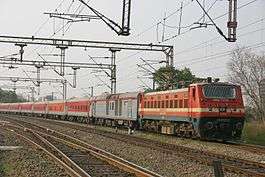
WAP-4 hauling Rajdhani Express
-
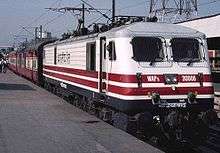
WAP-5 hauling Rajdhani Express
-

WAP-7 hauling Rajdhani Express
-
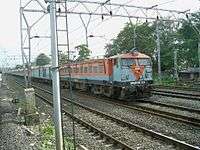
WCAM-2 hauling Rajdhani Express
-
.jpg)
WDP-4 loco hauling Rajdhani Express
Coaches
The coaches in these trains are of crash-worthy design from Alstom-LHB, built by Rail Coach Factory at Kapurthala.[5][6] These Alstom-LHB coaches can be pulled to a speed of 160 km/h without any modification.[7] New fast-express coaches are made partly or completely of stainless steel, primarily motivated by lower maintenance, and higher availability. Stainless steel construction also reduces empty weight, enabling more passengers per coach.[8] The bogies, design from Fiat, has 2 disk brakes per axle[7] essential for safe operations especially at the speed of fast-express trains.
Speed
The average speed of superfast trains, range from 55 kilometres per hour (34 mph) to 112 kilometres per hour (70 mph). Of this, counting up and down trains separately, 23 trains have an average speed more than 80 km/h, whereas, 72 trains have an average speed between 70 and 80 km/h. The speed of express trains is calculated from the latest Indian Railways Time-Table.
Regular unbranded express trains on the same route are only slightly slower, since the same locomotives haul them.
- Fastest Train in India: 12049/50: Agra Cantonment - H. Nizamuddin Gatimaan Express- Maximum Speed 160 km/hr, Average Speed 112 km/hr
- Second Fastest Train in India: 12002 New Delhi - Bhopal Habibganj Shatabdi Express- Maximum Speed 150 km/hr, Average Speed 100 km/hr
- Third Fastest Train in India: 12951 Mumbai - New Delhi Rajdhani Express and 12034 New Delhi - Kanpur Shatabdi Express- Maximum Speed 140 km/hr, Average Speed is between 80 and 95 km/hr
- Fourth Fastest Train in India: 12302 New Delhi - Howrah Rajdhani Express and 12260 New Delhi - Sealdah Duronto Express- Maximum Speed 135 km/hr, Average Speed is between 90 and 95 km/hr
- Fifth Fastest Train in India: 12273 New Delhi - Howrah Duronto Express, New Delhi - Allahabad Duronto Express and 12249 Howrah New Delhi Yuva Express- Maximum Speed is between 120 and 130 km/hr, Average Speed is between 80 and 85 km/hr
- Fastest Rajdhani: 12951 Mumbai - New Delhi Rajdhani Express- 140 km/hr
- Fastest Shatabdi: 12002 New Delhi - Bhopal Habibganj Shatabdi Express- 150 km/hr
- Fastest Suvidha: 22355 Patna - Mumbai CST Suvidha Superfast Express- 110 km/hr
- Fastest Duronto: 12260 New Delhi - Sealdah Duronto Express- 135 km/hr
- Fastest Yuva: 12249 Howrah New Delhi Yuva Express- 130 km/hr
- Fastest Garib Rath: 12910 H. Nizamuddin – Bandra Garib Rath- 130 km/hr
- Fastest Jan Shatabdi: 12059 Kota - H. Nizamuddin Jan Shatabdi Express- 110 km/hr
- Fastest Sampark Kranti: 12908 Maharashtra Sampark Kranti Express- 110 km/hr
- Fastest Double Decker: 12932 Mumbai Central - Ahmedabad AC Double Decker Express- 130 km/hr
- Fastest Air-Conditioned Superfast: 22109 Mumbai LTT - H. Nizamuddin AC SF Express- 130 km/hr
- Fastest Superfast Train: 12908 Maharashtra Sampark Kranti Express- 110 km/hr
- Fastest Passenger Train: 56719 Nagercoil – Kanyakumari Passenger – 62 km/hr
- Fastest EMU/MEMU/DEMU Train: 31213 Sealdah – Barrackpore EMU – 66 km/hr
Gallery
-

A WAP 5 hauled Gatimaan express Chandru Express
-

12302 Howrah Rajdhani Express - AC First Class
-

12259 Sealdah - New Delhi Duronto Express
-

12322 Mumbai Mail Superfast Express at Barddhaman Junction
-
_at_Khalor%2C_West_Bengal.jpg)
12510 Kaziranga Superfast Express (SBC-Guwahati) at Bagnan
-

12105 Vidarbha Superfast Express at Chandur
-

12073 (Howrah-Bhubaneswar) Jan Shatabdi Express (pic by Sarbamit Chowdhury)
-
_01.jpg)
12727 Godavari Superfast Express at Marripalem
-

12113 Garib Rath Express at Nagpur
-
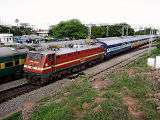
17036 Telangana Express at Moulali
-

18237 Chhattisgarh Express
-
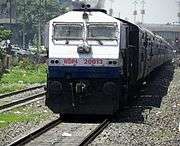
15483 Mahananda Express at Siliguri Town
-
_Express.jpg)
18625 (Patna-Hatia) Express
-

12864 Yesvantpur-Howrah Superfast Express at Marripalem
Stops
Frequent stops reduce the average running speed of a train greatly by preventing it from gaining higher speed. Duronto, Shatabdi, and Rajdhani express trains have very few stops. The distance between stops is as short as 2 km between New Bongaigaon-Bongaigaon on the Howrah-Dibrugarh Kamrup Express, and as long as 528 km between Vadodara-kota on the Thiruvananthapuram Rajdhani Express.
See also
- High-speed rail in India
- Rajdhani Express
- Shatabdi Express
- Duronto Express
- Jan Shatabdi Express
- Garib Rath
- Rajya Rani Express
References
- ↑ http://m.timesofindia.com/india/Indias-fastest-train-completes-final-test-run-in-record-time/articleshow/47534278.cms. Missing or empty
|title=(help) - ↑ Routes and Timetables of New Tejas, Uday, Humsafar and Antyodaya Trains
- ↑ High Speed – T.R.Natarajan, Indian Railways
- ↑ Indian Railways 2020 Vision – Government of India Ministry of Railways (Railway Board) December, 2009
- ↑ "To make fast-express trains safe, new design of coach on anvil". indianexpress.com. 25 January 2010. Retrieved 2013-03-11.
- ↑ Rlys may raise stainless steel coach production – BusinessLine
- 1 2 SYNOPSIS OF PAPERS PRESENTED IN SEMINAR ON ‘LHB COACH AND NEW MANUFACTURING TECHNOLOGIES’ HELD AT RCF, KAPURTHALA ON 4TH AND 5TH NOVEMBER’ 2003
- ↑ "Stainless Steel in Rail Transportation - stainlesssteel.org" (PDF). Retrieved 2013-03-11.
